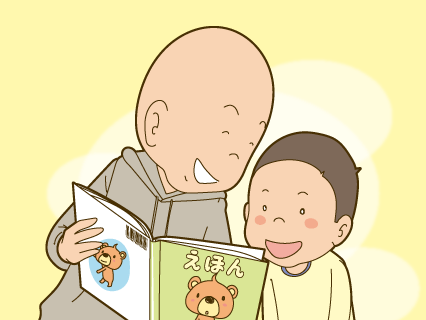Table of Contents
- Parenting Manga “Sleepy Dad and Sleepytime Picture Book”
- Tips for entertaining children with picture book readings
Parenting Manga “Sleepy Dad and Sleepytime Picture Book”
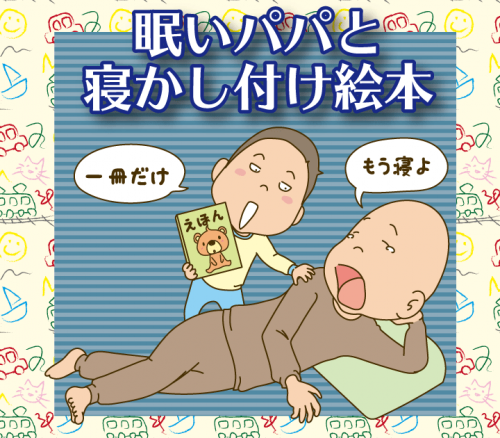
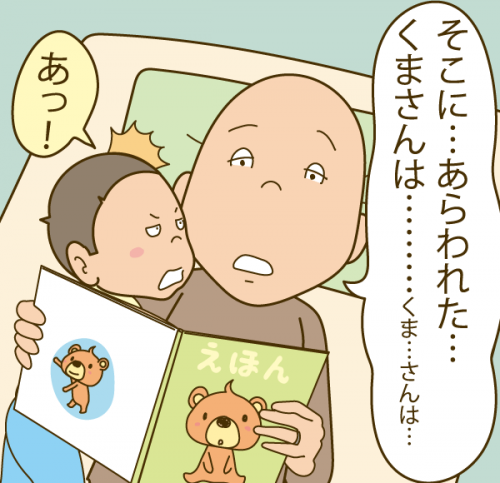
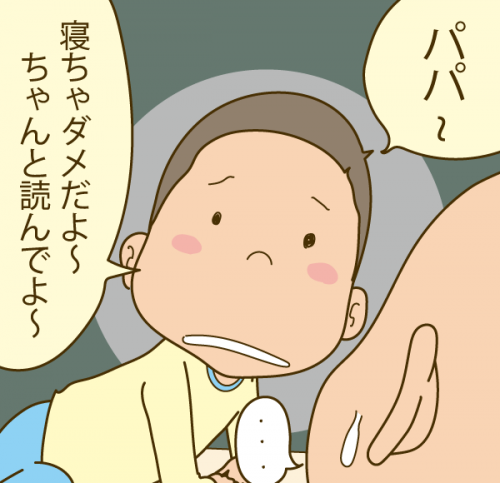
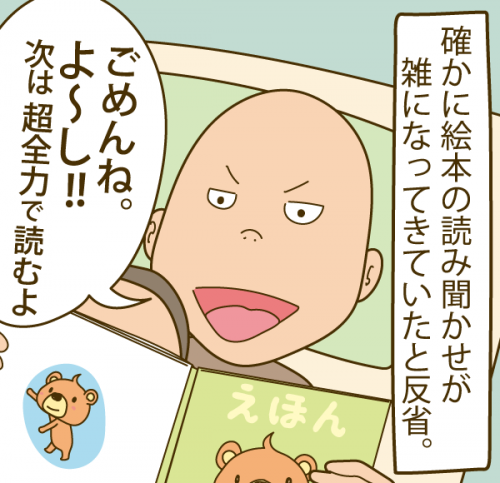
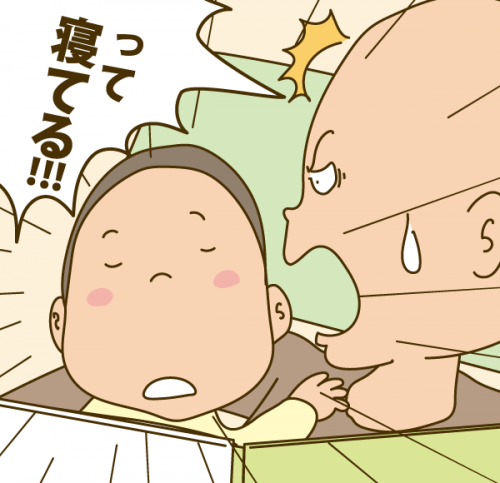
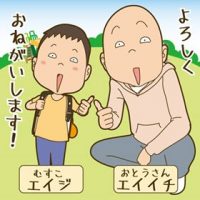
Profile
Eiichi
After working for a design company in Tokyo, he became a freelance illustrator. He is a hard-working father who creates animation, manga, and illustrations, including winning the Yubari International Fantastic Film Festival’s International Short Film Showcase Division Excellence in Animation Award.
Tips for entertaining children with picture book readings
I want to read picture books to my children.
But I don’t know what kind of picture booktochoose.
I don’t even know howtoread it.
For dads with such concerns,
Picture book experts sent their advice.
Advice from Specialists (1)
Tips for selecting picture books
You can choose the picture book of your choice!
The first theme is what kind of picture book to choose. We asked Mr. Toru Okudaira, director of the picture book shopping site “Picture Book Navi” and an expert on a wide range of picture books from classic to new releases. Mr. Okudaira also organizes many picture book reading events as a volunteer.
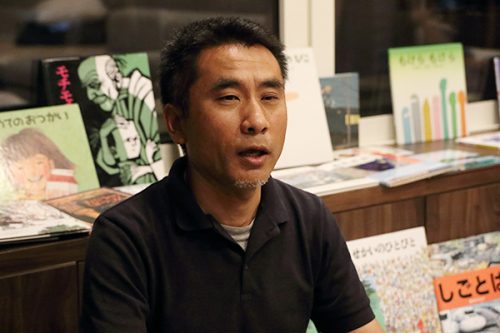
How to Choose, Part 1
Dad chooses, Mom chooses, we both choose.
The first important thing is for mom and dad to each choose, or for the two of them to discuss the choice together. If only one of mom and dad chooses, the content will inevitably be biased. Not only mom and dad, but also grandparents can choose. When many people are involved in the selection of picture books, the range of content will be broadened, which will lead to a wider world for the child.
How to choose No. 2
Choose picture books that moms and dads themselves like.
While it is important to attend to the child’s interests and preferences, it is also important that the parents themselves love the picture book. If the reader finds the book interesting, that enjoyment will be conveyed to the child who is the listener. Therefore, if you are not sure what to choose, try to choose a picture book that you like. It can be a picture book that you liked as a child. If you like dogs now, it could be a picture book featuring dogs. If you liked vehicles as a child, a picture book about vehicles would be good.
If you liked vehicles, this is the work for you.

“Departure!”
Created by Tadataka Yamamoto, Fukuinkan Shoten
This is a picture book by Tadataka Yamamoto, who has been drawing vehicles with great finesse. His attention to detail makes this work popular among both adults and children. The change of scenery from city to countryside in the process of transferring from limited express to express and then to local trains evokes nostalgia in adults.
How to choose No.3
Choose a picture book that brings your voice to life.
The next point is voice. The way a story is conveyed depends on the reader’s voice. There are some works and situations that are more exciting when read in a low voice by the father or a high voice by the mother. For example, I would like you to read the following piece to your father.
This is the kind of work that is more exciting with a low voice.
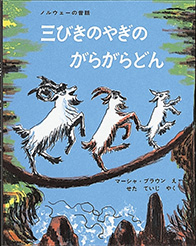
The Three Little Goats and the Rattlesnake
Picture: Marsha Brown Translation: Sette Teiji Fukuinkan Shoten
In this picture book, there are many scenes in which a low voice is effective, such as the monster troll’s terrific lines and the strong-looking big goat’s lines. Onomatopoeic words such as “gatan, gaton” and “gatan, gaton” are also very powerful with a low voice. This is a work that not only the child listening to it but also the father reading it can enjoy.
How to choose No. 4
Enjoy the fun and rhythm of language
You may think that if you are going to read a book to your child, it should be something with a lesson, but we encourage you to read picture books that are just fun and feel good. Children love picture books where they simply enjoy the fun of the words and the rhythm of the sounds, rather than thinking about what the message is. They are fun to listen to and feel good. They are fun to read and pleasant to listen to. This kind of comfort is also important when reading to children.
If you enjoy the rhythm of words, this is the work for you.
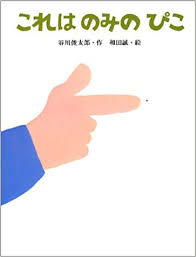
This is only Piko.
Created by Shuntaro Tanikawa Illustrated by Makoto Wada Sunreed
This is a picture book that should be read with a good sense of rhythm. Shuntaro Tanikawa’s humor and Makoto Wada’s stylish illustrations work well together. There are many picture books by this duo, so if you like this one, please pick up their other works.
The picture books introduced here are selected from booklets produced by the Tama Metropolitan Library. Many other picture books and reading materials are also introduced here, so please visit the Metropolitan Library website for more information.
https://www.library.metro.tokyo.jp/junior/
Advice from Specialists (2)
Tips on how to read
Look at the child’s expression rather than the picture book.
When I finished reading a picture book, the child said, “One more time! when I finish reading a picture book. This is the most joyful moment. So, how do you read a book to make a child happy? We asked Tsuyoshi Otomo, who holds picture book reading and concert events throughout Japan.
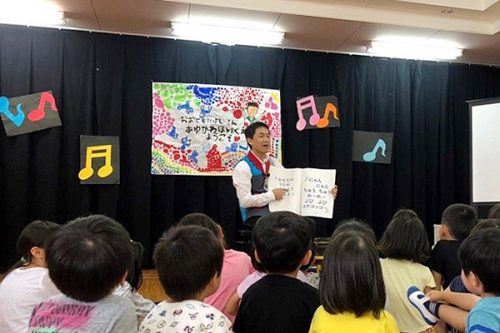
Mr. Otomo reading to children
How to Read Part 1
Watch your child closely.
First, I hope that moms and dads will enjoy reading to themselves. I would even go so far as to say that reading to them is a form of self-expression done through picture books. So the important thing is how you want to read. You never have to read well. First of all, cherish the time you spend reading to your children. I believe that the time spent reading picture books will be a treasure for your child.
What I try to do is to carefully observe the child’s facial expressions when I read to him or her. For example, if a child seems restless and takes a long time to face a picture book, I wait for him or her to slow down. Read the child’s expression to find out what he or she is feeling and what he or she is enjoying, and then change the reading style, such as changing the speed, to accommodate the child. In this way, even with the same picture book, you can enjoy a different live experience every day. When we talk about reading picture books, we tend to focus only on the picture book. Reading to children is a communication with children through picture books. I would like you to remember to pay attention to the child’s condition.
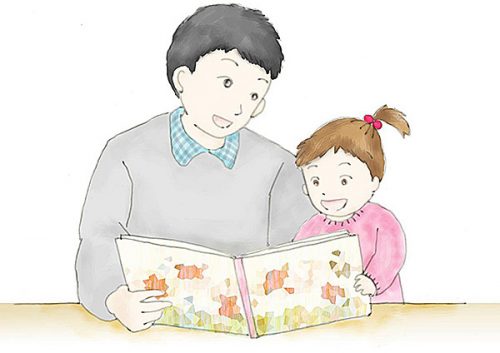
Reading Part 2
Keep the staging low key.
I also enjoy directing depending on the character or scene, but I often feel that overdoing it does not work well, so I tend to take a step back in my expression. I tend to take a step back in my expression. I try to “direct a little bit,” such as lowering my voice just a little bit or using my breath a little bit more. Also, when I am about to say, “This is it! I whisper in a quiet voice when I am about to say, “Here it comes! I think it is counterproductive to speak loudly in order to attract attention.
How to Read Part 3
Keeping up with Children’s Interests
I also want to take care of what my child is interested in. I also have a son, so I sometimes read at home, and when I do, I attend to what he is paying attention to to the fullest extent. Children are geniuses at digressions. Unlike adults, they see details, and sometimes a child will respond to something in a picture book and remember an event that excited him that day.
For example, he would blurt out that the color of the pebble in the corner of the picture resembled the color of the praying mantis he saw for the first time that day. At such times, I stop reading to him and take my time to talk about how sensational and dramatic his encounter with the praying mantis was. I enjoy this dialogue and use it to help me choose a picture book for the next storytime. Reading a picture book to a child is a form of communication. I do not believe that the goal is to read a picture book all the way through to the end.
If you are bringing small children, there are also libraries equipped with a “Baby/Flat” space where you can breastfeed and change diapers. You can find them on the “Tokyo Kosodate Switch” child-raising support website.
https://kosodateswitch.jp/flat/
Advice from Specialists (3)
Storytelling Tips
Let’s have a conversation with a hand picture book!
Think of your outstretched hands as a picture book and tell the story that comes into your head. That is “Otehtee ehon” (picture book with hands). It is fun to expand the conversation with a child’s original story. However, creating a story is difficult even for adults. We asked Satoshin, a picture book author who has been making efforts to popularize “oote ehon” (picture book with hands), for tips.
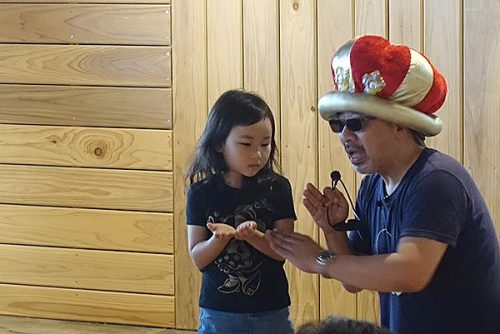
Satoshin-san leading a “Otei ehon” (picture book) while conversing with a child.
How to create a story Part 1
Ask questions that are easy for children to answer, and use them as a starting point.
Have you ever had trouble when your child asks you to “tell a story?” Making up a story is difficult even for adults. It is the same for children. Therefore, it is good to have an opportunity to make up a story at the beginning. For example, “What is your favorite animal? What did you have for breakfast? or other questions that are easy for children to answer. The answers to these questions are the start of the story.
After the child begins to tell the story, I interject with a question. Then what? And then?” And then what happened?” I ask. The child thinks, trying to answer. When he still can’t come up with the next story, he asks, “And then who came?” or “That animal might have been hungry, right?
But don’t forget to interject words of praise for your child, not just questions. “That’s a great idea! That’s amazing! and “That’s amazing!” This will encourage the child to speak more actively.
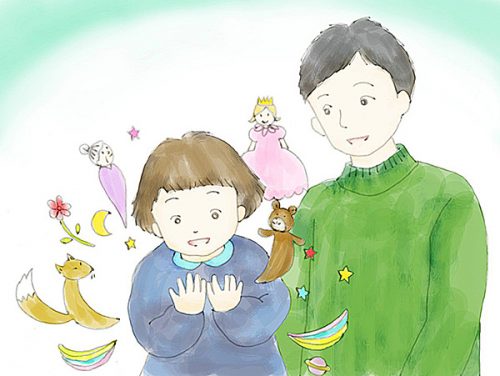
How to make a story, Part 2
Thinking together about the continuation of the story or another development of the picture book
If questions do not bring up a story, you can try to think together about the rest of the story after reading a picture book, or try to come up with another story. For example, after reading “Momotaro,” ask the child, “What if there had been another animal in Momotaro’s household? When the child mentions some animal, ask questions such as, “What would that animal be good at?” and let the story unfold.
Making Stories Part 3
Catching up on your stories
Another way to enjoy “Otehtee ehon” is to play “catch-ball” with the story. Parents and children take turns making up stories as if playing catch with each other. The story may take an unexpected turn, which is enjoyable. If this method is further developed, a “relay reading” in which many people participate in making a story together is recommended. The story is created in turn as if passing the baton. Have grandparents and children’s friends join in the fun and enjoy it together.
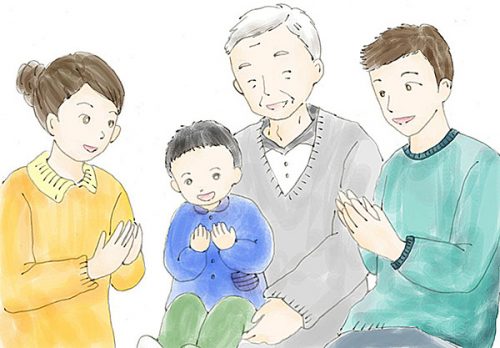
How to make a story Part 4
You don’t have to ask for a good or fun story.
What I want you to keep in mind with “Otei-ehon” is not to ask for only “good stories. Adults tend to set standards while saying, “Speak freely. Since the story is told freely, it does not have to be in order, and it does not have to be an imitation of an animated cartoon or picture book. What is important is that the child enjoys talking. Parents should accept this as it is.

If you are not sure which picture book to choose, just choose the one you like. There is no need to read it with an elaborate performance. For “Otehtee ehon” (picture book with hands), just accept a child’s story. None of the advice from the specialists was difficult. Please feel free to pick up a picture book and enjoy reading to your child.


